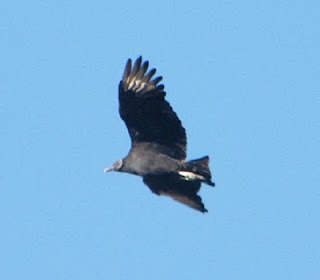I noted how I was walking through the Greystone property and found a large flock of vultures on the ground, running after each other. I had only known of vultures circling overhead or roosting in groups in tall trees.
 |
| Turkey vulture, picture by R.E. Berg-Andersson |
For one thing, one of my favorite authors, Margaret Maron, in her most recent Deborah Knott mystery, "The Buzzard Table," uses information provided by the Turkey Vulture Society as headers for each chapter. Yes, there is a Turkey Vulture Society. Lots of interesting data.
The book cover shows turkey vultures circling a house, but aside from the section headers the "buzzards" are not identified as turkey vultures at all. That miffed me. As a birder, I want precise information! My husband makes fun of me for this - we'll be watching a commercial and what interests me is not the car, say, but trying to identify the hawk flying in the background.
Anyway, there is a reference to the white feathered tips of the vultures' wings, which makes me think they could be black vultures, more likely to be seen in North Carolina, where this book takes place.
Closer to home, I've been studying the vultures that populate parts of the old Greystone mental hospital property in Parsippany, NJ - not so much their feeding or breeding habits as there are lots of places to learn about these birds, including Cornell's Lab of Ornithology - but how they deal with cold.
Last year, I thought the vultures would roost in evergreens in cold before moving to bare deciduous trees to warm up before flying in search of food. Turns out vultures are much smarter than that.
 |
| Black vultures roosting on a building bordering the Greystone property, a picture I took. |
Some of them, particularly the black vultures, would be found on home roofs in the sun, where the heat coming out of the chimney would provide warmth. When the property was a mental hospital, vultures might've congregated on the roofs of the hulking stone buildings where the patients were kept. Those buildings are now gone.
But there is also a large mixed flock that congregates on the ground in an area where trees block the cold wind from the north and west but not the rising sun from the east. They also stay low in the trees, particularly on windy days. I thought these were just black vultures, which are smaller and have silver heads, but when a few would fly up and circle before coming back I would see the white along the wings' trailing edge and realize it was a turkey vulture.
 |
| Black vulture - notice the white wing tips. Photo by R.E. Berg-Andersson |
When it is warm, however, I have noticed the black vultures roost in one group of trees while the turkey vultures stay in another. The status quo is preserved.
Luckily for the vultures, the park provides the space to keep them safely away from humans. Fifty vultures might look imposing in a tree but they are a major hassle if they are in YOUR backyard tree. So far there's been no clamor to get rid of the vultures, a protected species under federal law.
So what can we all learn from the vulture?
In tough times it is better to band together because there's safety in numbers.
 When you're a stranger in town, it is better to learn from the locals than try to impose your way on them.
When you're a stranger in town, it is better to learn from the locals than try to impose your way on them.
Oh, and maybe don't look too closely at what your neighbor is eating.

No comments:
Post a Comment